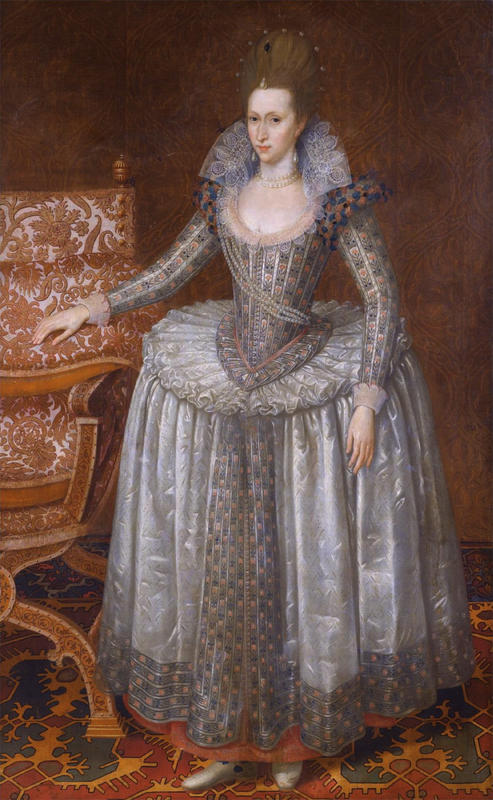More about Anne of Denmark

Contributor
As you can see, Anne of Denmark both meets and exceeds the most stringent definition of the Royal Bling Standard.
She's got the dress, the pose, a collar as high as her pearl-adorned beehive - altogether she looks as regal as one of Joe Exotic's tigers. However, we don't call her "Queen Anne" because she's not the "Queen Regnant," like Elizabeth I or II. "Regnant" refers specifically to those who hold their royal titles by bloodline, as opposed to queens consort, who "consort with," i.e. marry, kings. Oddly, when men marry into British royalty, they can't be "King Consort"—Queen Victoria tried to give the title to her husband Albert, but the Prime Minister put the kibosh on that.
Anne of Denmark was Queen consort of England, Scotland, and Ireland, and the wife of another de Critz patron, King James I. Historian John Bold suggests that this work accompanied a pendant portrait of James I, but the location of the companion piece is unknown. A doppelganger of this work hangs in Blickling Hall, in Norfolk, England. Nine years after he finished this work, de Critz decorated the triple-arched loggia in the garden, as well as 84 panels of wainscot for the interior of Denmark house, renamed for Anne of Denmark, its resident. Recent research suggests that de Critz went blind around the year he finished this portrait—did he keep working by intuition, like the elderly Monet?
The brilliant architect Inigo Jones, of no relation to Inigo Montoya, designed the Queen's House for Anne of Denmark, a magnificent Palladian-style estate that features the first-ever set of helical, DNA-shaped, stairs in England without a central support. Unfortunately, Anne didn't live long enough to move into the residence, which is now part of the National Maritime Museum in Greenwich, London.
One of Queen Anne's claims to fame is her bold appearance in a series of masques, or court plays, with her ladies. For European women, she was a trailblazer in the world of performance, and she employed Inigo Jones and the playwright Ben Jonson, for a handsome price, in assembling her productions. One of the unfortunate costs of her masques was that they served to establish among the nobility the idea of an innate connection between skin color and palatability—her blackface performance in The Masque of Blackness was so controversial that she followed it up with The Masque of Beauty, in which the "AEthiopian" protagonists of the previous masque bleached their skin to better approximate the court's idea of beauty.
Sources
- "Anne of Denmark, 1574–1619." Royal Museums Greenwich, https://collections.rmg.co.uk/collections/objects/201233.html.
- "ANNE OF DENMARK (1574 – 1619), QUEEN OF JAMES VI & I." The Weiss Gallery, https://www.weissgallery.com/artworks/9376-john-de-critz-1552-1642-anne….
- Bell, Lynne, Arthur Bousfield, and Garry Toffoli. Queen and Consort: Elizabeth and Philip - 60 Years of Marriage. Ontario: Dundurn, 2007.
- Bold, John. Guidance on Inventory and Documentation of the Cultural Heritage. Strasbourg: Council of Europe, 2009.
- "James I and Anne of Denmark." Historic Royal Places, https://www.hrp.org.uk/banqueting-house/history-and-stories/james-i-and….
- Semler, Liam E. The Early Modern Grotesque: English Sources and Documents 1500-1700. London: Routledge, 2018.
- Town, Edward. "Whilst he had his perfect sight' - new information on John de Critz the Elder." Burlington magazine 154, no. 1312 (2012): 482-486.











